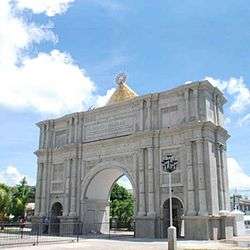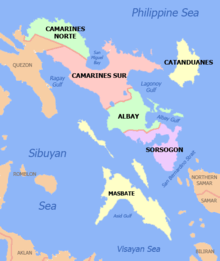Pamplona, Camarines Sur
Pamplona, officially the Municipality of Pamplona, is a 4th class municipality in the province of Camarines Sur, Philippines. According to the 2015 census, it has a population of 36,390 people.[3]
Pamplona | |
|---|---|
| Municipality of Pamplona | |
 Municipal Hall | |
 Map of Camarines Sur with Pamplona highlighted | |

| |
.svg.png) Pamplona Location within the Philippines | |
| Coordinates: 13°36′N 123°05′E | |
| Country | |
| Region | Bicol Region (Region V) |
| Province | Camarines Sur |
| District | 2nd district |
| Founded | May 5, 1885 |
| Barangays | 17 (see Barangays) |
| Government | |
| • Type | Sangguniang Bayan |
| • Mayor | Gemino A. Imperial |
| • Vice Mayor | Ronaldo F. Franco |
| • Congressman | Luis Raymund F. Villafuerte Jr. |
| • Electorate | 15,808 voters (2019) |
| Area | |
| • Total | 80.60 km2 (31.12 sq mi) |
| Elevation | 7.1 m (23.3 ft) |
| Population (2015 census)[3] | |
| • Total | 36,390 |
| • Density | 450/km2 (1,200/sq mi) |
| • Households | 7,567 |
| Economy | |
| • Income class | 4th municipal income class |
| • Poverty incidence | 38.75% (2015)[4] |
| • Revenue (₱) | 84,807,064.72 (2016) |
| Time zone | UTC+8 (PST) |
| ZIP code | 4416 |
| PSGC | |
| IDD : area code | +63 (0)54 |
| Climate type | tropical rainforest climate |
| Native languages | Central Bikol Tagalog |
History
The beginnings of this town can be traced back from the date it was made a visita of Milaor.The town of Pamplona was founded in 1817.[5] It first started as a settlement in Western area of the Bicol River, then it grew to become a Sitio called Patong. The name was changed to Pamplona by a Retired Spanish Military Officer who resided in the place and named it after his native city in Spain - Pamplona, capital of Basque, Province of Navarro.[6]
Historical references concluded that most Spaniards inhabiting the place came from the province of Pamplona in Spain and thus decided to name their settlement also as "Pamplona".
Pamplona officially became a parish on May 8, 1885, which coincided with the date of the town's celebration honoring their patron saint, St. Michael Archangel.
Barangays
Pamplona is politically subdivided into 17 barangays.
- Batang
- Burabod
- Cagbibi
- Cagbunga
- Calawat
- Del Rosario
- Patong
- Poblacion
- Salvacion
- San Gabriel
- San Isidro
- San Rafael
- San Ramon
- San Vicente
- Veneracion (Taguilid)
- Tambo
- Tampadong
Demographics
| Population census of Pamplona | |||||||||||||||||||||||||||||||||||||||||||||||||
|---|---|---|---|---|---|---|---|---|---|---|---|---|---|---|---|---|---|---|---|---|---|---|---|---|---|---|---|---|---|---|---|---|---|---|---|---|---|---|---|---|---|---|---|---|---|---|---|---|---|
|
| ||||||||||||||||||||||||||||||||||||||||||||||||
| Source: Philippine Statistics Authority[3][7][8][9] | |||||||||||||||||||||||||||||||||||||||||||||||||
In the 2015 census, the population of Pamplona, Camarines Sur, was 36,390 people,[3] with a density of 450 inhabitants per square kilometre or 1,200 inhabitants per square mile.
Climate
As part of the Bicol Region, the municipality has a tropical climate favorable to agriculture. The fields remain lush-green throughout the year, even through a long drought period. Generally, there are only two distinct seasons, namely: dry and wet season. The dry season starts from about the middle or later part of January up to April and the wet season starts from May to December.
| Climate data for Pamplona, Camarines Sur | |||||||||||||
|---|---|---|---|---|---|---|---|---|---|---|---|---|---|
| Month | Jan | Feb | Mar | Apr | May | Jun | Jul | Aug | Sep | Oct | Nov | Dec | Year |
| Average high °C (°F) | 33 (91) |
31 (88) |
35 (95) |
37 (99) |
38 (100) |
37 (99) |
36 (97) |
34 (93) |
35 (95) |
34 (93) |
33 (91) |
32 (90) |
35 (94) |
| Average low °C (°F) | 27 (81) |
27 (81) |
29 (84) |
31 (88) |
32 (90) |
32 (90) |
30 (86) |
29 (84) |
30 (86) |
29 (84) |
28 (82) |
28 (82) |
29 (85) |
| Average precipitation mm (inches) | 44.2 (1.74) |
53.17 (2.09) |
45.43 (1.79) |
54.15 (2.13) |
92.29 (3.63) |
182.23 (7.17) |
289.11 (11.38) |
260.6 (10.26) |
180.07 (7.09) |
340.22 (13.39) |
98.7 (3.89) |
337.4 (13.28) |
1,977.57 (77.84) |
| Average rainy days | 21 | 22 | 19 | 19 | 24 | 26 | 30 | 29 | 27 | 29 | 24 | 29 | 299 |
| Source: World Weather Online[10] | |||||||||||||
Economy
Farming is considered to be the main source of livelihood and basically agriculture is the primary source where most households derive their income. The agricultural products includes coconuts, upland crops and rice. Agricultural workers outnumbering the ones who are employed in non-agricultural occupations. As of 1997, 66.2% are engaged in agricultural works while 33.8% make up the non-agricultural labor force.
Industries include cottage industries and bamboo furniture industry with agricultural equipment manufacturer found in Barangay San Gabriel, making portable hand tractors, palay treshers, and portable wind blowers.
The rehabilitation of farm-to-market roads was started to link the barangays to the trade and commerce industry. This will facilitate the transport of farm products and farm inputs.
The town has four barangay high school in San Vicente, San Isidro, Poblacion and Veneracion. It also has 11 barangay elementary school and two primary schools.
References
- "Municipality". Quezon City, Philippines: Department of the Interior and Local Government. Retrieved 31 May 2013.
- "Province: Camarines Sur". PSGC Interactive. Quezon City, Philippines: Philippine Statistics Authority. Retrieved 12 November 2016.
- Census of Population (2015). "Region V (Bicol Region)". Total Population by Province, City, Municipality and Barangay. PSA. Retrieved 20 June 2016.
- "PSA releases the 2015 Municipal and City Level Poverty Estimates". Quezon City, Philippines. Retrieved 1 January 2020.
- History of Pamplona (May 17, 2013) Retrieved from http://www.pamplona.gov.ph/History.html
- Brief History of Pamplona (May 17, 2013) Retrieved from http://www.pamplona.gov.ph/History.html
- Census of Population and Housing (2010). "Region V (Bicol Region)". Total Population by Province, City, Municipality and Barangay. NSO. Retrieved 29 June 2016.
- Censuses of Population (1903–2007). "Region V (Bicol Region)". Table 1. Population Enumerated in Various Censuses by Province/Highly Urbanized City: 1903 to 2007. NSO.
- "Province of Camarines Sur". Municipality Population Data. Local Water Utilities Administration Research Division. Retrieved 17 December 2016.
- "Pamplona, Camarines Sur: Average Temperatures and Rainfall". World Weather Online. Retrieved 29 October 2017.
External links
| Wikimedia Commons has media related to Pamplona, Camarines Sur. |

